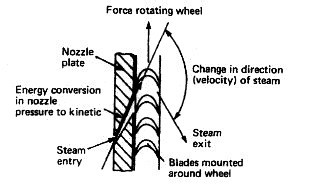Steam turbines control
The steam turbine has until recently been the first choice for very large power marine propulsion units. Its advantages of little or no vibration, low weight, minimal space requirements and low maintenance costs are considerable. Furthermore a turbine can be provided for any power rating likely to be required for marine propulsion. However, the higher specific fuel consumption when compared with a diesel engine offsets these advantages, although refinements such as reheat have narrowed the gap.

Fig: Energy conversion in a steam turbine
The valves which admit steam to the ahead or astern turbines are known as 'manoeuvring valves'. There are basically three valves, the ahead, the astern and the guarding or guardian valve. The guardian valve is an astern steam isolating valve. These valves are hydraulically operated by an independent system employing a main and standby set of pumps. Provision is also made for hand operation in the event of remote control system failure.
Operation of the ahead manoeuvring valve will admit steam to the main nozzle box. Remotely operated valves are used to open up the remaining nozzle boxes for steam admission as increased power is required. A speed-sensitive control device acts on the ahead manoeuvring valve to hold the turbine speed constant at the desired value. Operation of the astern manoeuvring valve will admit steam to the guardian valve which is opened in conjunction with the astern valve. Steam is then admitted to the astern turbines.
Turbine protection
A turbine protection system is provided with all installations to prevent damage resulting from an internal turbine fault or the malfunction of some associated equipment. Arrangements are made in the system to shut the turbine down using an emergency stop and solenoid valve. Operation of this device cuts off the hydraulic oil supply to the manoeuvring valve and thus shuts off steam to the turbine. This main trip relay is operated by a number of main fault conditions which are;
1. Low lubricating oil pressure.
2. Overspeed.
3. Low condenser vacuum.
4. Emergency stop.
5. High condensate level in condenser.
6. High or low boiler water level.
Other fault conditions which must be monitored and form part of a total protection system are:
1. HP and LP rotor eccentricity or vibration.
2. HP and LP turbine differential expansion, i.e. rotor with respect to casing.
3. HP and LP thrust bearing weardown.
4. Main thrust bearing weardown.
5. Turning gear engaged (this would prevent starting of the turbine).
Such 'turbovisory' systems, as they may be called, operate in two ways. If a tendency towards a dangerous condition is detected a first stage alarm is given. This will enable corrective action to be taken and the turbine is not shut down. If corrective action is not rapid, is unsuccessful, or a main fault condition quickly arises, the second stage alarm is given and the main trip relay is operated to stop the turbine.
Dear friends,
ReplyDeleteI want to present my new blog devoted to Mechanical Engineers, who perform their professional duties in the different parts of the World Ocean despite the difficult working conditions. The primary purpose of this blog is to help them in their daily hard work. Author hopes that the technical documentation, articles and notes, which are posted on this blog, will be interesting for both experienced professionals and novice mechanicians, which are just beginning their careers. Also I think that this blog will be useful for all mechanicians because many of the described machines and mechanisms are widely used ashore.
Please visit:
http://www.marineenginers.blogspot.ru